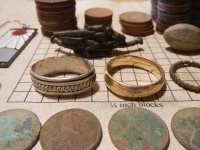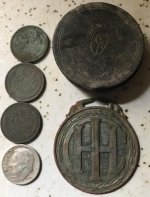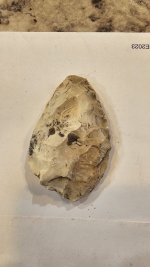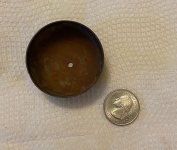Gypsy Heart
Gold Member
Likely burial sites sold
By REBECCA SULOCK
ROCK HILL — York County museum leaders sold land containing Catawba Indian relics and likely burial grounds to a developer, despite pleas from at least five archaeologists that the property first be thoroughly surveyed.
The land was sold to Cherokee Investment Partners earlier this year, to be developed as a residential and retail community surrounding the planned Museum of Life and Environment on the banks of the Catawba River.
The site has been studied to some extent and the archaeological reports turned over to the developer, said York County Culture & Heritage Museums director Van Shields. The sites that have been identified will be protected, he said.
But the sales agreement contains no specific covenants protecting the sites, according to Shields and a Cherokee official. Cherokee is working on a site plan for the development, to be called Kanawha.
“We did our work as best as possible while the property was in our stewardship,” Shields said.
Jane Spratt McColl donated the 400-acre tract in 1998. Money from development of 350 acres as a “green,” or environmentally sustainable, community will be used to help pay for the proposed $50 million Museum of Life and Environment.
A thorough archaeological survey would take time and money — likely more than $10,000 — and the museum organization has not had the resources, museum officials said.
But researchers and scholars who have walked the property from the University of North Carolina at Chapel Hill, the University of North Carolina at Charlotte, the University of South Carolina and the S.C. Institute of Archaeology and Anthropology say they urged Shields and others several years ago to examine the property in-depth, based on the discovery of what looked to be two rare mid-18th-century Catawba villages.
“There are highly significant archaeological resources present on that property,” said Brett Riggs, a staff archaeologist at UNC-Chapel Hill’s research archaeology labs.
Riggs and professor R.P. Stephen Davis Jr. specialize in 18th- and 19th-century Catawba history and have worked intensively on several digs in York and Lancaster counties.
Riggs and Davis believe they have found two lost Catawba settlements on the site. The two villages are likely to yield hundreds of burial sites, Davis said, because they date around the time of a devastating smallpox epidemic that killed scores of Catawbas.
Catawba leaders are concerned about the villages and haven’t had any official word from museum officials about the archaeological work there.
“We’ve known for quite some time the area has a very high probability of having not just those sites, but quite possibly a number of others that are of interest to us,” said Wenonah Haire, director of the Catawba cultural center on the tribe’s York County reservation. “We had asked we be brought in from the very beginning.”
Shields says the museum’s archaeologist has met with Catawba tribal members about the site. “There’s an open dialogue between Wenonah Haire and the Catawba folks,” Shields said. “We’ve been in pretty constant contact with the Catawbas over the years.”
However, Haire said the Catawbas haven’t had significant contact with the museum for years. “Those that are in the know, that are at the top, should be contacting us,” Haire said. “We haven’t gotten that.”
USC professor of anthropology Gail Wagner and professor Carole Crumley, specialist in historical ecology at UNC-Chapel Hill, were both invited several years ago to York County to discuss ideas about the planned museum.
They learned that no significant archaeological study had been done on the entire 400 acres and brought their concerns to Shields, they said. “We said, ‘We’re concerned; what are your plans?’” Wagner said. “We know there are some sites and can predict there will be others. It was obvious he didn’t want us to pursue it.”
Others attempted to collaborate on working at the site, with offers of potential undergraduate labor and donated equipment, said Sam Thomas, former director of curatorial affairs at the museum.
Those offers were dismissed, said Thomas, who resigned earlier this year. Thomas served as the liaison between the archaeologists and the museum management, he said. For seven years he tried to get a survey done on the site, he said.
“Right after the donation, from that point on we started immediately saying an archaeological survey needed to be done,” said Thomas, now the curator of the T.R.R. Cobb House museum in Athens, Ga. “They kept saying they didn’t have the money to do that right now, but they would do it later. Every time I worked it into the budget, it kept getting cut out. We had a number of archaeologists who were willing to donate time.”
State archaeologist Jon Leader tried to develop a working relationship between his office and the museum, Leader said. He offered help from his office on several occasions over the years but still is waiting to hear back from museum leaders.
“We were more than willing to assist,” Leader recalled. “We met with Van Shields and the heads of the museum. But the final decision on how one chooses to or does not choose to deal with the property is in the hands of the manager.”
Shields said he did not recall such offers of help. “I don’t know of a situation where I’ve been offered, where we’ve been presented with an opportunity to collaborate without compensation,” he said. “I don’t know about that. I’m not in a position to hire people on a willy-nilly basis.”
Leader and the university archaeologists said they never approached Shields for employment. Leader came to Shields as the head of one largely taxpayer-funded institution to another, in an attempt to work for the mutual benefit of each, he said.
“It was a good project all the way around,” he said of the offer to collaborate. “It was pretty straightforward.”
The chairman of the Culture & Heritage Commission, the 21-member board charged with making policy decisions for the museum organization, said he had not heard of any free offers of help.
“We’re more than happy to work with these people who want to provide services,” said Gary Williams, who is serving his first term as commission chairman. “If someone’s offered their services free, I know nothing about it. We wouldn’t reject anyone’s service.”
When Jane McColl donated the land eight years ago, museum officials had a decision to make: Take a quick $10 million by selling it or get a steady stream of cash by developing the property, Williams said. “We’re trying to maximize as much money as we can get out of it, but we’re trying to do it in an environmentally and historically correct way,” Williams said.
McColl is wife of former Bank of America chairman and CEO Hugh McColl and sister of U.S. Rep. John Spratt of York.
Leaders have been working steadily on development of the environmentally progressive Museum of Life and Environment, designed by world-renowned architect William McDonough. The museum will replace the aging and poorly located facility on Mount Gallant Road, and will tell the story of the relationship between people and place.
Fundraising is still in the “quiet” phase of the campaign. When the Cherokee deal was announced, museum officials estimated the residential-commercial development would bring in about $17 million to $20 million for the museum.
Cherokee Investment Partners, a Raleigh-based investment firm, will develop the property in a partnership with a museum group. Cherokee shares the museum’s vision for how the property needs to be developed, and that will emphasize conservation and preservation, museum leaders say.
“We’re balancing a lot of those features in a way that would normally be ignored on a site like this,” said Brian Goray, managing partner of the Kanawha development. “We’re trying to create something really special.” Although no one has approached him about archaeological digs, Goray said activity at key sites could enhance the community.
“We think historical features on the site are an important part of the development,” he said. “Known archaeological features are being incorporated in the preliminary land planning process.”
Sometime in the next few months, a preliminary site plan for the Kanawha project likely will be turned in to the town of Fort Mill, Goray said. Work on the site could begin next year.
Some archaeologists worry the site’s development will erase important parts of the historical record in a rush to raise the money necessary for the massive new museum.
“We told them this York County area has an extremely interesting history, the white settlers, history of the Catawbas, the history of the slave population, there’s a lot going on,” said Davis of UNC-Chapel Hill. “The county museum’s proper role is to provide an understanding of that history for its citizens. One way you don’t do that is by blasting away the evidence of that history. It seems like the area where we know the sites are may be impacted by a housing development.”
Shields and Williams say they take their charge to protect and preserve the county’s history very seriously.
“Our professional staff are totally committed to doing what’s best for that property and I’ve seen nothing but that as evidence,” Williams said. “We are caretakers of land and will do everything possible to take care of this land.”
Sulock is a reporter for the (Rock Hill) Herald, a McClatchy newspaper.
http://www.thestate.com/mld/thestate/news/local/15483447.htm
By REBECCA SULOCK
ROCK HILL — York County museum leaders sold land containing Catawba Indian relics and likely burial grounds to a developer, despite pleas from at least five archaeologists that the property first be thoroughly surveyed.
The land was sold to Cherokee Investment Partners earlier this year, to be developed as a residential and retail community surrounding the planned Museum of Life and Environment on the banks of the Catawba River.
The site has been studied to some extent and the archaeological reports turned over to the developer, said York County Culture & Heritage Museums director Van Shields. The sites that have been identified will be protected, he said.
But the sales agreement contains no specific covenants protecting the sites, according to Shields and a Cherokee official. Cherokee is working on a site plan for the development, to be called Kanawha.
“We did our work as best as possible while the property was in our stewardship,” Shields said.
Jane Spratt McColl donated the 400-acre tract in 1998. Money from development of 350 acres as a “green,” or environmentally sustainable, community will be used to help pay for the proposed $50 million Museum of Life and Environment.
A thorough archaeological survey would take time and money — likely more than $10,000 — and the museum organization has not had the resources, museum officials said.
But researchers and scholars who have walked the property from the University of North Carolina at Chapel Hill, the University of North Carolina at Charlotte, the University of South Carolina and the S.C. Institute of Archaeology and Anthropology say they urged Shields and others several years ago to examine the property in-depth, based on the discovery of what looked to be two rare mid-18th-century Catawba villages.
“There are highly significant archaeological resources present on that property,” said Brett Riggs, a staff archaeologist at UNC-Chapel Hill’s research archaeology labs.
Riggs and professor R.P. Stephen Davis Jr. specialize in 18th- and 19th-century Catawba history and have worked intensively on several digs in York and Lancaster counties.
Riggs and Davis believe they have found two lost Catawba settlements on the site. The two villages are likely to yield hundreds of burial sites, Davis said, because they date around the time of a devastating smallpox epidemic that killed scores of Catawbas.
Catawba leaders are concerned about the villages and haven’t had any official word from museum officials about the archaeological work there.
“We’ve known for quite some time the area has a very high probability of having not just those sites, but quite possibly a number of others that are of interest to us,” said Wenonah Haire, director of the Catawba cultural center on the tribe’s York County reservation. “We had asked we be brought in from the very beginning.”
Shields says the museum’s archaeologist has met with Catawba tribal members about the site. “There’s an open dialogue between Wenonah Haire and the Catawba folks,” Shields said. “We’ve been in pretty constant contact with the Catawbas over the years.”
However, Haire said the Catawbas haven’t had significant contact with the museum for years. “Those that are in the know, that are at the top, should be contacting us,” Haire said. “We haven’t gotten that.”
USC professor of anthropology Gail Wagner and professor Carole Crumley, specialist in historical ecology at UNC-Chapel Hill, were both invited several years ago to York County to discuss ideas about the planned museum.
They learned that no significant archaeological study had been done on the entire 400 acres and brought their concerns to Shields, they said. “We said, ‘We’re concerned; what are your plans?’” Wagner said. “We know there are some sites and can predict there will be others. It was obvious he didn’t want us to pursue it.”
Others attempted to collaborate on working at the site, with offers of potential undergraduate labor and donated equipment, said Sam Thomas, former director of curatorial affairs at the museum.
Those offers were dismissed, said Thomas, who resigned earlier this year. Thomas served as the liaison between the archaeologists and the museum management, he said. For seven years he tried to get a survey done on the site, he said.
“Right after the donation, from that point on we started immediately saying an archaeological survey needed to be done,” said Thomas, now the curator of the T.R.R. Cobb House museum in Athens, Ga. “They kept saying they didn’t have the money to do that right now, but they would do it later. Every time I worked it into the budget, it kept getting cut out. We had a number of archaeologists who were willing to donate time.”
State archaeologist Jon Leader tried to develop a working relationship between his office and the museum, Leader said. He offered help from his office on several occasions over the years but still is waiting to hear back from museum leaders.
“We were more than willing to assist,” Leader recalled. “We met with Van Shields and the heads of the museum. But the final decision on how one chooses to or does not choose to deal with the property is in the hands of the manager.”
Shields said he did not recall such offers of help. “I don’t know of a situation where I’ve been offered, where we’ve been presented with an opportunity to collaborate without compensation,” he said. “I don’t know about that. I’m not in a position to hire people on a willy-nilly basis.”
Leader and the university archaeologists said they never approached Shields for employment. Leader came to Shields as the head of one largely taxpayer-funded institution to another, in an attempt to work for the mutual benefit of each, he said.
“It was a good project all the way around,” he said of the offer to collaborate. “It was pretty straightforward.”
The chairman of the Culture & Heritage Commission, the 21-member board charged with making policy decisions for the museum organization, said he had not heard of any free offers of help.
“We’re more than happy to work with these people who want to provide services,” said Gary Williams, who is serving his first term as commission chairman. “If someone’s offered their services free, I know nothing about it. We wouldn’t reject anyone’s service.”
When Jane McColl donated the land eight years ago, museum officials had a decision to make: Take a quick $10 million by selling it or get a steady stream of cash by developing the property, Williams said. “We’re trying to maximize as much money as we can get out of it, but we’re trying to do it in an environmentally and historically correct way,” Williams said.
McColl is wife of former Bank of America chairman and CEO Hugh McColl and sister of U.S. Rep. John Spratt of York.
Leaders have been working steadily on development of the environmentally progressive Museum of Life and Environment, designed by world-renowned architect William McDonough. The museum will replace the aging and poorly located facility on Mount Gallant Road, and will tell the story of the relationship between people and place.
Fundraising is still in the “quiet” phase of the campaign. When the Cherokee deal was announced, museum officials estimated the residential-commercial development would bring in about $17 million to $20 million for the museum.
Cherokee Investment Partners, a Raleigh-based investment firm, will develop the property in a partnership with a museum group. Cherokee shares the museum’s vision for how the property needs to be developed, and that will emphasize conservation and preservation, museum leaders say.
“We’re balancing a lot of those features in a way that would normally be ignored on a site like this,” said Brian Goray, managing partner of the Kanawha development. “We’re trying to create something really special.” Although no one has approached him about archaeological digs, Goray said activity at key sites could enhance the community.
“We think historical features on the site are an important part of the development,” he said. “Known archaeological features are being incorporated in the preliminary land planning process.”
Sometime in the next few months, a preliminary site plan for the Kanawha project likely will be turned in to the town of Fort Mill, Goray said. Work on the site could begin next year.
Some archaeologists worry the site’s development will erase important parts of the historical record in a rush to raise the money necessary for the massive new museum.
“We told them this York County area has an extremely interesting history, the white settlers, history of the Catawbas, the history of the slave population, there’s a lot going on,” said Davis of UNC-Chapel Hill. “The county museum’s proper role is to provide an understanding of that history for its citizens. One way you don’t do that is by blasting away the evidence of that history. It seems like the area where we know the sites are may be impacted by a housing development.”
Shields and Williams say they take their charge to protect and preserve the county’s history very seriously.
“Our professional staff are totally committed to doing what’s best for that property and I’ve seen nothing but that as evidence,” Williams said. “We are caretakers of land and will do everything possible to take care of this land.”
Sulock is a reporter for the (Rock Hill) Herald, a McClatchy newspaper.
http://www.thestate.com/mld/thestate/news/local/15483447.htm
Amazon Forum Fav 👍
Upvote
0






